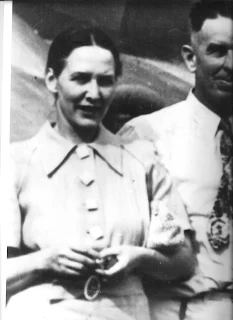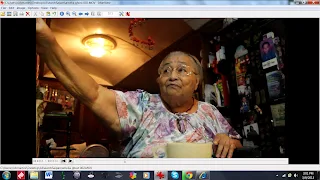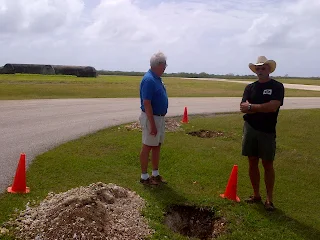Aircraft Recovery Associates refutes the arguments advanced by The International Group for Historic Aircraft Recovery researchers in their research paper on the reliability of witnesses.
In their research paper titled, “Amelia Earhart, Saipan, and the Reliability of Eyewitnesses,” TIGHAR researchers Dr. Thomas F. King, Thomas A. Roberts, and Joseph A. Cerniglia cited studies as they offered caution in connection with “uncritical reliance on eyewitness accounts – particularly when these accounts have been gathered by untrained personnel and have been frequently retold.”

EARHART RESEARCHERS CAPTAIN PAUL COOPER, MIKE HARRIS, AND RICHARD MARTINI ANSWER QUESTIONS FROM THE AUDIENCE DURING A PUBLIC PRESENTATION AT AMERICAN MEMORIAL PARK LAST MONTH. PHOTO BY ALEXIE VILLEGAS ZOTOMAYOR
|
TIGHAR is exploring the Nikumaroro Hypothesis, that Amelia Earhart and her navigator Fred Noonan may have crash landed on Gardner Island, now Nikumaroro, in the Phoenix Islands in the Republic of Kiribati.
In response, Aircraft Recovery Associates lead investigator Richard Martini, on behalf of the group said that the comment borders on “unintentional racism,” implying that the islanders aren’t capable of accurately recalling their own memories.
“Are these researchers saying that these islanders we’ve interviewed are lying? Or that they are being manipulated? Are they stating that the U.S. Marines are lying? Or that they are being manipulated?” asked Martini.
Martini, a journalist and an award-winning documentary filmmaker, has been conducting his own research for the past 25 years.
Martini e-mailed this reporter their response and posted a copy on their website earhartonsaipan.com.
“There’s no such thing as ‘unintentional manipulation’ — a clever catch-phrase to make it seem that ‘oh, they must be making this up because the camera is convincing them to lie about what they heard or saw.’”
Citing the article published by Variety last Friday, Martini said, “The article claims that “even word choice by a questioner can influence memory,’ which of course is possible, unless you’re someone who’s been doing this for some time, and knows how to ask a person to recollect whatever it is they want to recollect.
King et al. stated in their paper, “Most of the eyewitness and other accounts by American military personnel are subject to similar forms of unintentional manipulation, memory construction, and faulty interpretation. Although there may be kernels of truth in some or many of the stories, there are ways of accounting for them that do not involve the presence of Earhart and/or Noonan in the Marianas.”
For Martini, “manipulation” is a pejorative and that there are no two ways around it. “Either a person is manipulated or they are not,” he said.
Martini said, “It may be ‘unintentionally racist’ because it’s been the history of Saipan, the history of the Chomorro people, that if an American can’t understand them, or take the time to ask them questions about their lives, about their personal experience during the war, they couldn’t possibly be telling the truth about what they heard or saw from their parents. The Chomorro were first told by the Spanish what to say or believe, then told by the Germans what they should or shouldn’t learn, and then by the Japanese on what they could or couldn’t say. And then when the CIA was based in Saipan until 1962, another group of people would tell them how to speak or what they could or could not say. Our exprience on Saipan is that everyone has secrets to tell, but in general, has chosen not to tell them.”
Martini also described as “paternalistic” and “chauvinistic” the TIGHAR researchers “expertise masquerading as science.”
He said it has little or nothing to do with science or the pursuit of the truth.
He said this is typical “of people who have a vested interest in their own version of the truth.”
“For example, one man we interviewed, 82 years old, said he was 12 years old when he saw a female fitting Earhart’s description sitting with her arms bound behind her in the back of a army truck parked prior to the War in Chalan Kanoa. He said, ‘I clearly remember it, as the truck was parked for 30 minutes, and I had never seen a white person before.’ We asked him questions about other details about the war, about his family hiding in caves. These and other details we were able to corroborate. Why would he slip one lie into an hour of truth?”
Martini said that the Chamorro people interviewed couldn’t be “cajoled or “manipulated in any fashion to say something they didn’t actually witness.”
He also said that a Chamorro will say that he or she didn’t see it personally and say that somebody else did.
“A Chomorro will say ‘I did not see this personally, and I repeat that it was my mother or father who saw it, so I can’t say that it happened, but this is what they said. He didn’t say it was Amelia Earhart. He said it was a ‘tall, thin woman wearing a khaki shirt with light colored hair with her arms bound behind her back and a black bandana across her face.’ If he was being manipulated — or trying to obfuscate — why not just say ‘I saw Amelia Earhart?” He did not know who she was, but he did see her as a prisoner prior to the war.”
Martini said they take the time to corroborate information.
Citing as an example what a U.S. Marine relayed to him, Martini said the veteran told him, “I remember it as if it was yesterday. I was the wire operator in Col. Clarence Wallace’s tent. I decoded the message that came in on June 19, 1944 that said ‘We have found Amelia Earhart’s airplane on Aslito airfield.’ I took the message to my commanding officer and he signed it. And I thought it was odd that he made no comment about it. And then he ordered me to the hangar to guard the plane for 24 hours.’”
Martini said they corroborated this story in interviews with other soldiers who saw this man guarding the plane.
“What part of his story was made up? What part was ‘manipulated?” he said.
Martini said, “To call a U.S. Marine a liar is, in our humble opinion, beyond the pale. Oh sorry — he was ‘unintentionally manipulated’ into repeating what he saw. Well, we have news for these researchers; the camera, in this case, doesn’t lie. This Marine spoke the truth and we have five other corroborating witnesses. And we’d like to see them tell a Marine to his face that he was ‘unintentionally manipulated.’”
“To imply that as a filmmaker, or a journalist, we have somehow manipulated people into saying what they think they saw, as opposed to what they saw, or what their parents told them they saw, is to imply we’ve been unintentionally (or intentionally) manipulating eyewitnesses,” said Martini.
The veteran filmmaker also said, “As a team, we’ve been at this for enough time to understand the difference between conjecture and reporting.”
The Aircraft Recovery Associates said, their premise is simple: let the people speak for themselves about what they saw or heard.
“We suspect those who choose to ignore the overwhelming accounts do so because of an inherent disregard of native islanders, or US Marines, or both,” said Martini.
Martini said the TIGHAR group has been developing and testing their hypothesis that Earhart wound up on Nikumaroro for 30 years.
“Isn’t it time to step back for a moment and consider that there might be some logic to what all of these eyewitnesses have said? After all, if the premise was true that people can spontaneously make up memories based on wishful thinking, where are all the witnesses who saw her on some other island? If it’s true that the U.S. Marines might have been deluded by the fog of war, why didn’t they say she was on Iwo Jima, Okinawa or Guam?” said Martini.
For Martini, one cannot ignore the fact that over a dozen soldiers claim they found her plane, saw her plane, or watched it burn at As Lito airfield.
“This was only 7 years after it disappeared — it’s not like they’d had a chance to come up with some other scenario,” he said.
Aside from these soldiers, he said, there were over 200 eyewitness accounts.
In the span of three weeks, they managed to get 15 new eyewitnesses.
“Logic tells us that these accounts bear further scrutiny — not that they may be incorrect, or manipulated, which is faulty reasoning — any cop can tell you that when eyewitnesses agree upon something, then it’s worth pursuing. That is, unless they’re being ‘unintentionally manipulated’ of course,” said Martini.


































